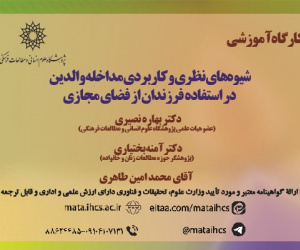تغییراتِ ریتمیک کرشمه در پیش درآمدهای درویش خان (مقاله علمی وزارت علوم)
درجه علمی: نشریه علمی (وزارت علوم)
آرشیو
چکیده
در پژوهش حاضر چگونگی استفاده از گوشه کرشمه به عنوان مهم ترین دورِ ریتمیک موجود در موسیقی کلاسیک ایرانی در پیش درآمدهای درویش خان که از بنیان گذاران ژانر پیش درآمد در موسیقی ایرانی شناخته می شود بررسی شده است. به این منظور روش های ایجاد دگره ریتمیک در کرشمه های ردیف مورد بررسی قرار گرفته و با روش هایی که درویش خان در ساختن پیش درآمد از کرشمه استفاده کرده مقایسه شده اند. این پژوهش که به طور کلی برپایه تحقیقات کتابخانه ای و گردآوری منابع نوشتاری و صوتی انجام شده علاوه بر این که نشان می دهد کرشمه یکی از عوامل مهمِ سازنده ساختار ریتمیکِ نخستین پیش درآمد های ساخته شده در موسیقی کلاسیک ایرانی است روش های به کار رفته در ایجاد تنوع و دگره نیز در ردیف و پیش درآمدهای مذکور مشابه اند. این روش ها به طورکلی با تغییر در افزایش یا کاهشِ تعداد یا دیرش نغمات و سکوت ها در تکرارهای پیاپیِ کرشمه شکل می گیرند. تفاوت عمده نحوه استفاده از این روش ها در پیش درآمدهای درویش خان عدم استفاده از دو روش افزایش و کاهشِ دیرشِ نغمات به دلیل ملاحظات متریک است. همچنین در این پیش درآمدها برای حفظِ ثباتِ متر استفاده از روش های افزایش و کاهشِ تعدادِ نغمات، کاهش یافته و روش های تجمیع و تقسیم نغمات و جایگزینیِ نغمه و سکوت بیشتر به کار رفته اند. شناخت و بهره گیری از روش های مذکور که بخشی از شیوه های آفرینش در موسیقی کلاسیک ایرانی را نشان می دهند می تواند دستمایه ای برای ساخت پیش درآمدهای امروزی باشد.Rhythmic Variations of Kereshmeh in Pishdaramad’s of Darvish-Khan
In this article, the method of using the Kereshmeh gusheh as the most important and widely used rhythmic cycle in Iranian classical music in the pishdaramads made by Gholamhossein Darvish, who is known as the inventor or one of the inventors of the pishdaramad genre in Iranian music, has been investigated. For this purpose, the methods of creating variety and creating rhythmic differences in Kereshmeh in various interpretations of the radifs have been studied and compared with the methods used by Darvish-Khan in making pishdaramad of Kereshmeh. Through the investigation of audio and written sources of Darvish Khan's works, it was found that there are seven pishdaramads from him, of which the rhythmic pattern of Kereshmeh is used in five of the pishdaramads. In four pieces out of these five preludes, the rhythmic pattern of Kereshmeh forms the main rhythmic structure and they are presented with various changes from the beginning to the end. In this article, these four pishdarmads have been examined, which are described in order as follows: 1. Mahur 2. Shushtari 3. Abuata 4. Abuata (second). The result of this study and comparison shows that Kereshmeh is one of the important constructive and generative factors in the rhythmic structure of the first preludes made in Iranian classical music. The known methods are divided into seven parts: 1. increasing the number of tones or rests; 2. reducing the number of tones or rests 3. increasing the duration of tones or rests; 4. reducing the duration of tones or rests; 5. Dividing the duration of tones or rests; 6. combining the duration of tones or rests; and 7. substitution of tones and rests. These methods are generally formed by increasing or decreasing the number of tones or rests, increasing or decreasing the duration of tones and rests, as well as replacing rests and tones in successive repetitions of the presentation of the rhythmic cycle of Kereshmeh. The main difference in the way these methods are used in Darvish Khan's pishdaramads is not using two methods of increasing the duration of tones and decreasing the duration of tones due to metrical considerations. Also, in these advances, to maintain the stability of the meter and prevent many changes in their metric structure, the use of methods of increasing and decreasing the number of notes has been reduced, and the methods of combining the duration of notes and dividing the duration of tones and replacing the tone and rests have been used more. Using the methods of increasing or decreasing the number of tones in this writing have been done only by removing or adding the part of the fa’alaton or mafa’elon in the rhythmic structure of Kereshmeh. Recognizing and using the mentioned methods that show some of the ways of composition in Iranian classical music can be a tool for making today's advances; also, the study of how to use other rhythmic cycle such as Masnavi in other genres of percussive pieces such as reng will complement this research.











